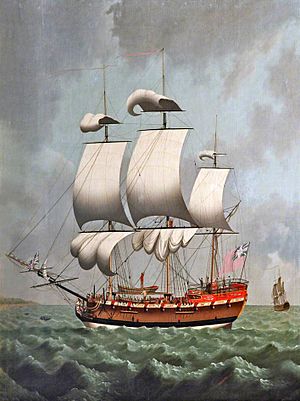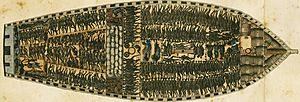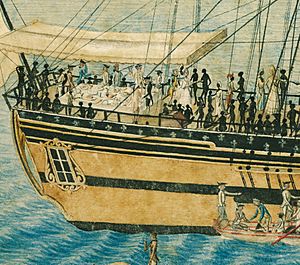William Whaley facts for kids
William Whaley was an English slave trader who lived a long time ago, around the 1700s. He was involved in at least 22 voyages that transported enslaved people from the Port of Liverpool. He was one of the biggest slave traders in the British colonies in America. Interestingly, he even employed two other important slave traders, William Davenport and William Earle, before they became famous on their own.
What Was the Slave Trade?
The slave trade was a terrible system where people were captured, bought, and sold as if they were property. They were forced to work without pay and had no freedom. William Whaley was part of this system. He took part in at least 22 voyages between 1750 and 1759, starting from the Port of Liverpool.
Whaley had business connections with important people, like John Ward, who owned a large house called Capesthorne Hall. In 1741, John Ward sent his grandson, William Davenport, to Liverpool to learn from Whaley. Davenport worked for Whaley for seven years, learning about trade, including the slave trade. Whaley was paid a lot of money to teach Davenport, which shows that Whaley's business was very important and offered good training.
After Davenport finished his training, he and Whaley became business partners. Between 1748 and 1753, they worked together on eight slave voyages. They were among the first to make Old Calabar (a place in modern-day Nigeria) a major trading spot for enslaved people. Later, William Davenport became the biggest slave trader in Britain, based on the number of voyages he completed.
Whaley also hired William Earle to be a captain on his slave ships. Earle later became one of the biggest slave traders from Liverpool himself. In 1750, Earle was the captain of a ship called the Chesterfield. This ship was owned by Whaley, Davenport, and others.
We know a lot about how these voyages worked because a letter with instructions for Captain Earle has been saved. This letter, dated May 22, 1751, told Earle to leave Liverpool and first go to Douglas on the Isle of Man. There, he was to buy goods that would be traded for African people and elephant tusks.
From the Isle of Man, he was to sail to Old Calabar and buy 350 people. The letter also gave Earle a special bonus: he could choose 5 people who, when sold, would bring money only to him, not to the ship owners. After buying the people, he was told to sail to the Caribbean, where the enslaved people would be sold. Finally, he was to buy goods for the return trip to England, which would then be sold in Bristol or London. A note added by Whaley said that Earle should buy as many elephant tusks as possible, even if it meant he couldn't buy all 350 people.
Whaley was also involved in the slave trade to the Chesapeake Bay area, which is now part of the United States. He transported 866 people on five slave voyages. This made him the seventh largest importer of enslaved people to that region in the early 1700s. After 1750, the British slave trade focused more on the West Indies and South Carolina. Whaley often sold enslaved people to Henry Laurens in South Carolina. Laurens was an important politician during the American Revolutionary War and also a very large slave trader and slave owner in British America.
Ships Used in the Slave Trade
William Whaley owned and invested in several ships used for the slave trade. Some of these ships included the Chesterfield, the Ann Gally, and the St. George.
About William Whaley's Life
William Whaley lived in places called Upholland and Eccleston, both in an area of England called Lancashire. He passed away around the year 1765.




